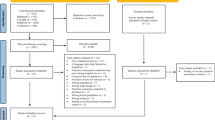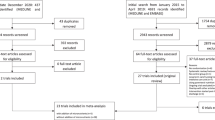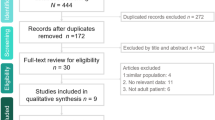Abstract
Objective:
Nutritional deficiency is an independent risk factor for mortality. Despite its clinical relevance, the prevalence in a primary care setting is poorly documented. We performed a systematic review of reported prevalence and clinical assessment of nutritional deficiency in general practice.
Methods:
From MEDLINE, Current Contents and EMBASE, we derived articles and checked the initially included ones for references on prevalence data. Of the eligible articles, we assessed the quality of research and results.
Results:
We finally included eight studies. The prevalence ranged from 0 to 13%. However, the study populations were heterogeneous and all studies contained methodological flaws, especially selection bias. In addition, the clinical assessment differed between studies.
Conclusion:
Literature on the prevalence of nutritional deficiency within general practice is rare and provides disputable prevalence assessments.
Sponsorship:
The Dutch Dairy Association, Zoetermeer.
This is a preview of subscription content, access via your institution
Access options
Subscribe to this journal
Receive 12 print issues and online access
$259.00 per year
only $21.58 per issue
Buy this article
- Purchase on Springer Link
- Instant access to full article PDF
Prices may be subject to local taxes which are calculated during checkout

Similar content being viewed by others
References
Akner G & Cederholm T (2001): Treatment of protein-energy malnutrition in chronic nonmalignant disorders. Am. J. Clin. Nutr. 74, 6–24.
Alderson P, Green S & Higgins JPT (2004): Cochrane Library, Issue 1. Chichester, UK: John Wiley & Sons Ltd.
Anker SD, Ponikowski P, Varney S, Chua TP, Clark AL, Webb-Peploe KM, Harrington D, Kox WJ, Poole-Wilson PA & Coats AJ (1997): Wasting as independent risk factor for mortality in chronic heart failure. Lancet 349, 1050–1053.
Beck AM, Ovesen L & Osler M (1999): The ‘Mini Nutritional Assessment’ (MNA) and the ‘Determine Your Nutritional Health’ Checklist (NSI Checklist) as predictors of morbidity and mortality in an elderly Danish population. Br. J. Nutr. 81, 31–36.
Beck AM, Ovesen L & Schroll M (2001): A six months prospective follow-up of 65+-y-old patients from general practice classified according to nutritional risk by the Mini Nutritional Assessment. Eur. J. Clin. Nutr. 55, 1028–1033.
Deitch EA (1995): Nutritional support of the burn patient. Crit. Care Clin. 11, 735–750.
DeVore PA (1993): Assessment of nutritional status and obesity in elderly patients as seen in general medical practice. South. Med. J. 86, 1008–1010.
Edington J, Boorman J, Durrant ER, Perkins A, Giffin CV, James R, Thomson JM, Oldroyd JC, Smith JC, Torrance AD, Blackshaw V, Green S, Hill CJ, Berry C, McKenzie C, Vicca N, Ward JE & Coles SJ (2000): Prevalence of malnutrition on admission to four hospitals in England. The Malnutrition Prevalence Group. Clin. Nutr. 19, 191–195.
Edington J, Kon P & Martyn CN (1996): Prevalence of malnutrition in patients in general practice. Clin. Nutr. 15, 60–63.
Edington J, Kon P & Martyn CN (1997): Prevalence of malnutrition after major surgery. J. Hum. Nutr. Dietetics 10, 111–116.
Engelen MP, Schols AM, Baken WC, Wesseling GJ & Wouters EF (1994): Nutritional depletion in relation to respiratory and peripheral skeletal muscle function in out-patients with COPD. Eur. Respir. J. 7, 1793–1797.
European Commission (1999): Towards a Europe for all ages—promoting prosperity and intergenerational solidarity. Commission of the European communities, Brussels (COM, No. 221final).
Fiatarone MA, O'Neill EF, Ryan ND, Clements KM, Solares GR, Nelson ME, Roberts SB, Kehayias JJ, Lipsitz LA & Evans WJ (1994): Exercise training and nutritional supplementation for physical frailty in very elderly people. N. Engl. J. Med. 330, 1769–1775.
Field CJ, Johnson IR & Schley PD (2002): Nutrients and their role in host resistance to infection. J. Leukocyte Biol. 71, 16–32.
Fockert JA (1991): In De voedingstoestand van de zieke ouderen (Syllabus Symposium), 1st Edn, ed. MA Verheul-Koot. Zoetermeer: Nutricia.
French SA, Jeffery RW, Folsom AR, Williamson DF & Byers T (1995): Relation of weight variability and intentionality of weight loss to disease history and health-related variables in a population-based sample of women aged 55–69 years. Am. J. Epidemiol. 142, 1306–1314.
Gregory J, Foster K, Tyler H & Wiseman M (1990): The Dietary and Nutritional Survey of British Adults. London: HMSO.
Kruizenga HM, Wierdsma NJ, van Bokhorts MAE, van der Schueren DE, Hollander HJ, Jonkers-Schuitema CF, van der Heijden E, Melis GC & van Staveren WA (2003): Screening of nutritional status in The Netherlands. Clin. Nutr. 22, 147–152.
Landbo C, Prescott E, Lange P, Vestbo J & Almdal TP (1999): Prognostic value of nutritional status in chronic obstructive pulmonary disease. Am. J. Respir. Crit. Care Med. 160, 1856–1861.
Larsson J, Akerlind I, Permerth J & Hornqvist JO (1995): Impact of nutritional state on quality of life in surgical patients. Nutrition 11, 217–220.
Lowenstein FW (1982): Nutritional status of the elderly in the United States of America, 1971–1974. J. Am. Coll. Nutr. 1, 165–177.
Martyn CN, Winter PD, Coles SJ & Edington J (1998): Effect of nutritional status on use of health care resources by patients with chronic disease living in the community. Clin. Nutr. 17, 119–123.
Mathus-Vliegen EM (2004): Old age, malnutrition, and pressure sores: an ill-fated alliance. J. Gerontol. A Biol. Sci. Med. Sci. 59, 355–360.
McWhirter JP & Pennington CR (1994): Incidence and recognition of malnutrition in hospital. BMJ 308, 945–948.
Miyagi K, Asanoi H, Ishizaka S, Kameyama T, Wada O, Seto H & Sasayama S (1994): Importance of total leg muscle mass for exercise intolerance in chronic heart failure. Jpn. Heart J. 35, 15–26.
Mostert R, Goris A, Weling-Scheepers C, Wouters EF & Schols AM (2000): Tissue depletion and health related quality of life in patients with chronic obstructive pulmonary disease. Respir. Med. 94, 859–867.
Naber TH, Schermer T, de Bree A, Nusteling K, Eggink L, Kruimel JW, Bakkeren J, van Heereveld H & Katan MB (1997): Prevalence of malnutrition in nonsurgical hospitalized patients and its association with disease complications. Am. J. Clin. Nutr. 66, 1232–1239.
Perissinotto E, Pisent C, Sergi G & Grigoletto F (2002): Anthropometric measurements in the elderly: age and gender differences. Br. J. Nutr. 87, 177–186.
Roberts SB, Fuss P, Heyman MB, Evans WJ, Tsay R, Rasmussen H, Fiatarone M, Cortiella J, Dallal GE & Young VR (1994): Control of food intake in older men. JAMA 272, 1601–1606.
Ryan C, Bryant E, Eleazer P, Rhodes A & Guest K (1995): Unintentional weight loss in long-term care: predictor of mortality in the elderly. South. Med. J. 88, 721–724.
Saletti A, Johansson L & Cederholm T (1999): Mini Nutritional Assessment in the elderly subjects receiving home nursing care. J. Hum. Nutr. Diet 12, 381–387.
Schols AM, Slangen J, Volovics L & Wouters EF (1998): Weight loss is a reversible factor in the prognosis of chronic obstructive pulmonary disease. Am. J. Respir. Crit. Care Med. 157, 1791–1797.
Shoup R, Dalsky G, Warner S, Davies M, Connors M, Khan M, Khan F & ZuWallack R (1997): Body composition and health-related quality of life in patients with obstructive airways disease. Eur. Respir. J. 10, 1576–1580.
Sullivan DH, Sun S & Walls RC (1999): Protein-energy undernutrition among elderly hospitalized patients: a prospective study. JAMA 281, 2013–2019.
Wahlqvist ML, Savige GS & Lukito W (1995): Nutritional disorders in the elderly. Med. J. Aust. 163, 376–381.
Wannamethee SG, Shaper AG, Whincup PH & Walker M (2000): Characteristics of older men who lose weight intentionally or unintentionally. Am. J. Epidemiol. 151, 667–675.
Wilson DO, Rogers RM, Wright EC & Anthonisen NR (1989): Body weight in chronic obstructive pulmonary disease. The National Institutes of Health Intermittent Positive-Pressure Breathing Trial. Am. Rev. Respir. Dis. 139, 1435–1438.
Wissing U & Unosson M (1999): The relationship between nutritional status and physical activity, ulcer history and ulcer-related problems in patients with leg and foot ulcers. Scand J. Caring Sci. 13, 123–128.
World Health Organisation (2003): Diet, nutrition, and the prevention of chronic disease. Report of a WHO/FAO study group, Technical Report Series, No. 916, WHO, Geneva.
Acknowledgements
We thank the Dutch Dairy Association for the financial support, Rob Scholten for the EMBASE contribution and Caroline Roos for translating the Spanish articles.
Author information
Authors and Affiliations
Corresponding author
Additional information
Guarantor: JJ van Binsbergen.
Contributors: CAMvW: protocol development, searching for articles, abstract and article assessment for eligibility, quality assessment, data extraction, and review development; FAvdL: protocol development, abstract and article assessment for eligibility, quality assessment, data extraction, and review development; WAvS: review development (editing); JJvB: protocol development and review development; CvW: protocol development (advisor) and article development.
Discussion after Van Wayenburg
Kolasa: Could you explain in more detail how the coding was done? The patient who may come to see you gets a diagnostic code? Are you encouraged or paid to do more than one? Because in the USA that would impact how many codes we see.
Van Wayenburg: I can only answer that question for myself when I am working in the general practice. I only try to aim at one illness, and to relate most complaints to that illness. But nutrition deficiency or weight loss does need a specific treatment, so it could be an entity on its own, like we discuss also obesity. We say someone has heart disease or cancer, and with that illness comes nutritional deficiency.
Helman: I guess that weight loss is seen as a symptom for which another diagnosis would be sought. I think the last thing that would occur to a GP is a nutritional deficiency.
Van Wayenburg: If you look at nutritional deficiency as being an independent risk factor for mortality, should we then be more aware to treat it as a separate illness? What do you think?
Helman: If most GPs understood the prevalence of deficiency in hospitals and nursing homes and they understood the impact on morbidity and mortality we would be a long way.
Van Wayenburg: So our next question will be in COPD patients to see how many of the patients are nutritionally deficient. That would be maybe good to emphasise it.
Pond: Picking up on this from the Australian point of view. We now have a 75+ y health assessment, and we have a GP version of a scale for being at risk of nutrition deficiency, which includes whether they eat alone, how many meals they eat a day and so on. I think the studies up till now are taken up very well by GPs, but so far we have not been able to prove that they act on this information. And there is no information on what to do.
Van Wayenburg: The definition of nutritional deficiency is unclear, and for that reason also not workable in practice. So that is something that we should maybe work on, to make this definition more clear. For example, it has been said that weight and height, BMI should be registered just as blood pressure, but I should say we should also define weight loss in the electronic system, so we get a better picture.
Rights and permissions
About this article
Cite this article
van Wayenburg, C., van de Laar, F., van Weel, C. et al. Nutritional deficiency in general practice: a systematic review. Eur J Clin Nutr 59 (Suppl 1), S81–S88 (2005). https://doi.org/10.1038/sj.ejcn.1602178
Published:
Issue Date:
DOI: https://doi.org/10.1038/sj.ejcn.1602178
Keywords
This article is cited by
-
Effect on body weight, quality of life and appetite following individualized, nutritional counselling to home-living elderly after rehabilitation – An open randomized trial
The Journal of nutrition, health and aging (2017)
-
Ondervoeding
Huisarts en wetenschap (2011)
-
Vroege herkenning en behandeling van ondervoeding
Tijdschrift voor praktijkondersteuning (2010)
-
Seeking the balance between individual and community-based nutritional interventions
European Journal of Clinical Nutrition (2005)



